T H E F I L M S T U D I E S W E B S I T E O F B E N T O N P A R K S C H O O L
"Breathless" is one of our set films in the world cinema section of the exam.
This question cannot be escaped nor can essential references to this set film.
In our study of "Breathless" we must:
*Know the film,s context.
*know technically how the film was made.
*know how it relates to other New Wave films
*know just what makes it a New Wave film
This will involve us in,
*learning appropriate background
*detailed micro and macro approaches to the film
*using the excellent DVD film commentary
*preparing timed essays from research on MRQE and
elsewhere on the net.
Modern movies begin here, with Jean-
Roger Ebert
A review of "Breathless" by Paul Ruspoli 1994
Godard, as well as other French auteurs of the time, admired American B movies for their directness and "because, in part, the French cinema of quality against which he railed had consciously differentiated itself from precisely those Hollywood genres like the gangster film." In fact, it was the French who coined the term "film Noir", to describe this American genre.
"All my avowed ambitions were to make a normal gangster film," said Godard in an interview. Although "normal" is not the first word that comes to mind viewing Breathless, and it is now categorized as a French New Wave film, the story line is directly and intensely influenced by American films: Michel, the antihero, is an amoral character and his death at the end of the film is inevitable. And, like in the American gangster films of the 1940’s, it is questionable if the death of the gangster is in fact a victory. Moreover, Michel shows overt signs of being influenced by characters such as those played by Humphrey Bogart. He is constantly rubbing his lips with a gesture stolen directly from "Bogey", and at one point he stops and stares at a poster of a Humphrey Bogart film and stares at his hero with idolization.
Finally, Breathless is dedicated, half jokingly, to Monogram Pictures, the primary producer of American gangster films.
Paul Ruspoli 1994
FULL CREDITS
Writing credits (in alphabetical order)
Jean-
François Truffaut story
Cast (in credits order)complete, awaiting verification
Jean-
Jean Seberg .... Patricia Franchini
Daniel Boulanger .... Police Inspector Vital
Jean-
Henri-
Van Doude .... Van Doude, The Journalist
Claude Mansard .... Claudius Mansard
Jean-
Richard Balducci .... Tolmatchoff
Roger Hanin .... Cal Zombach
Jean-
rest of cast listed alphabetically:
Liliane David .... Liliane
Jean Domarchi .... A Drunk
Jean Douchet .... A Journalist
Raymond Huntley .... A Journalist
André S. Labarthe .... A journalist
François Moreuil .... A journalist
Liliane Robin .... Minouche
José Bénazéraf .... (uncredited)
Philippe de Broca .... A Journalist (uncredited)
Michel Fabre .... Plainclothes Policeman (uncredited)
Louiguy .... (uncredited)
Michel Mourlet .... (uncredited)
Guido Orlando .... (uncredited)
Madame Paul .... (uncredited)
Raymond Ravanbaz .... (uncredited)
Jacques Serguine .... (uncredited)
Jacques Siclier .... (uncredited)
Virginie Ullmann .... (uncredited)
Emile Villion .... (uncredited)
Produced by
Georges de Beauregard .... producer
Original Music by
Martial Solal
Non-
Wolfgang Amadeus Mozart (from "Clarinet Concerto") (uncredited)
Cinematography by
Raoul Coutard
Film Editing by
Cécile Decugis
Lila Herman
Second Unit Director or Assistant Director
Pierre Rissient .... assistant director
Sound Department
Jacques Maumont .... sound
Other crew
Claude Beausoleil .... camera operator

I brought "amateur" techniques to movies. In "Breathless," I used the same techniques as Life reporters who, at the time, had nothing to do with Hollywood. I also used underexposed pictures, which were considered awful. But we were the people who said that this is part of human movies, too. Now it's very common”.
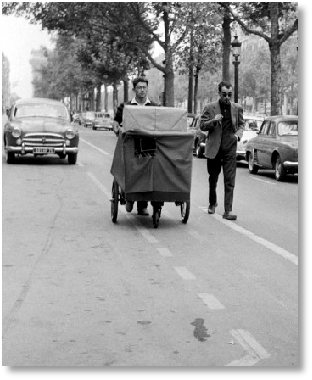


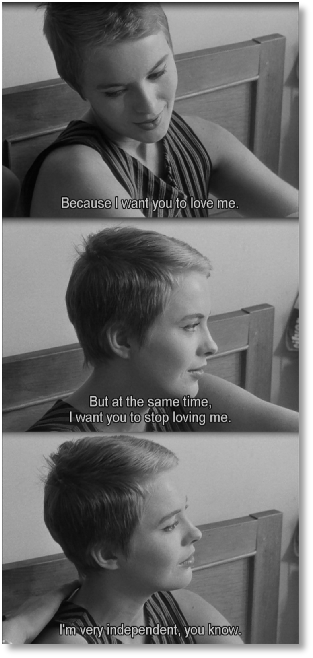

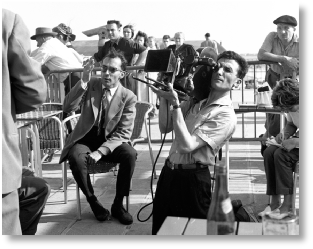
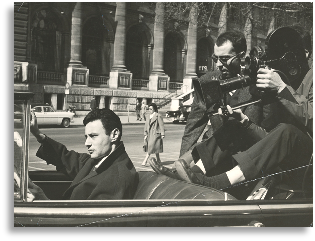

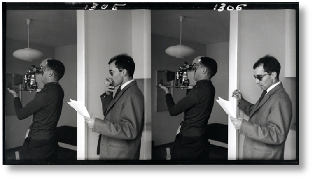
The filming of "Breathless" has gathered about it a body of legend. It was one of
the key films of the French New Wave, which rejected the well-
Many of the New Wave directors began as critics for the anti-
The credits for "Breathless" are a New Wave roll call, including not only Godard's direction but an original story by Francois Truffaut (Godard famously wrote each day's shooting script in the morning).
Claude Chabrol is production designer and technical adviser, the writer Pierre Boulanger plays the police inspector, and there are small roles for Truffaut and Godard himself (as the informer).
Everyone was at the party; the assistant director was Pierre Rissient, who wears so many hats he is most simply described as knowing more people in the cinema than any other single person.
Roger Ebert
But still, even though all of the movie’s revolutionary elements—its narrative inventions
and seat-
Breathless excites like no film since, and should be required viewing for anyone thinking of making a movie.
n fact, it should be required viewing for anyone thinking of even "thinking" about movies. Everything you could possibly come up with, every fresh idea, is right there in 89 minutes. Godard beat you to it.
Watch Breathless and you’ll see the birth of guerrilla cinema: jump cuts, handheld
shots, long unbroken takes, tracking moves accomplished with a wheelchair; scenes
filmed in natural light; street sequences shot without permits or lights or craft
services; gunshots and off-
Godard can be credited (or blamed) for the movies’ current obsession with self-
They are cool and they know it. Godard’s lovers and gangsters are paeans to the B-
Godard also embraced clichés and re-
And there are the popular songs, the cultural references, the brand names. This is Godard at his most referential, risking obsolescence by making his films for and about the "Pepsi Generation," yet his generation is just as obsessed as Generation X with love, movies, and product.
Godard also broke ground with his use of intertitles, dividing a film’s structure into segments. There are the random bursts of narrative anarchy, the endless sequences of talk. And there are the silences—the moments when all sound vanishes... It is here that the sadness of Godard’s legacy emerges, because so much in his movies has disappeared from contemporary cinema.
Rustin Thompson.
"I don't know if I'm unhappy because I'm not free, or if I'm not free because I'm
unhappy." -
Patricia: That's wrong. I think informing is very wrong.
Michel: No, it's life. Informers inform, burglars burgle, murderers murder, lovers love.


Pat: Do you know William Faulkner?
Michel: Someone you slept with?
Pat: No, of course not, silly.
Michel: Then the hell with him. Undress.
Pat: He's a writer. He wrote The Wild Palms.
Michel: Take your sweater off.
Pat: The last line is beautiful.... "Between grief and nothing, I'll take nothing."
When we talked, I talked about me, you talked about you, when we should have talked about each other.
Michel to Patricia

By 'eck Michel
we did talk some crap in that film
Glossary:
Jump cut -
A cutaway shot remedies the distracting jump appearance.
Cutaway Transitional footage normally inserted between cuts containing the same subject in slightly different screen positions to avoid a 'jump cut'. Not a favourite of Godard.
Dolly shot -
Master shot -
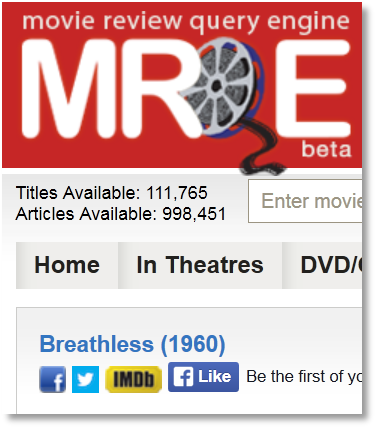
87
articles of varying quality to be found HERE
| Breathless |
| The 400 Blows |